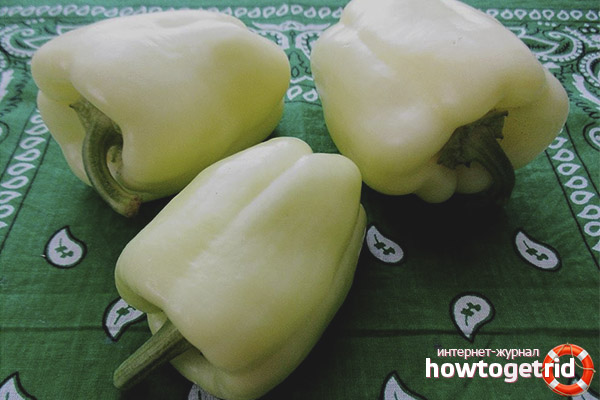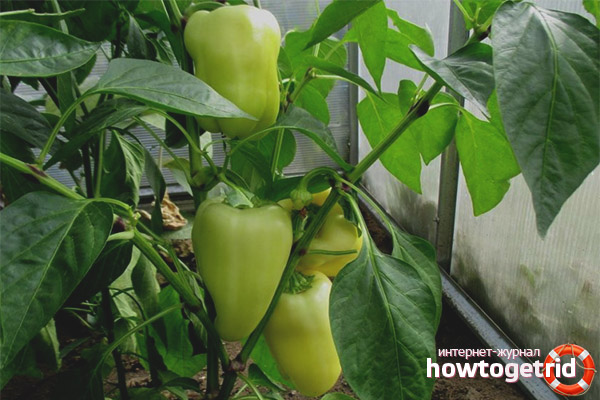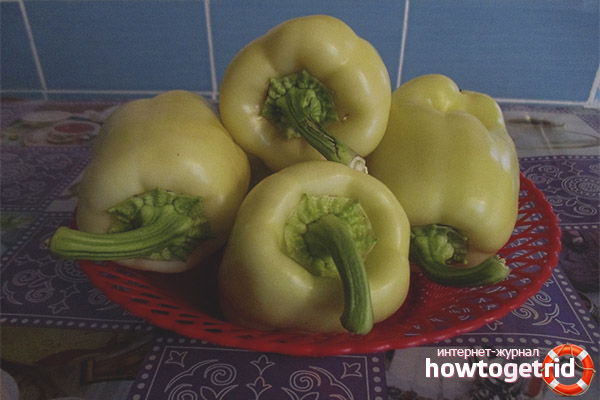The content of the article
White Gold bell pepper attracts landowners with its unique aroma and sweet taste. A bright color distinguishes it among representatives of other vegetable crops located on neighboring beds.
Grade description
The main agrotechnical characteristics of the plant:
- Early ripening grade. Fruits ripen from the moment of sowing within 110 days. At the same time, the fruits are basically not small.
- The fruits are rich in vitamins A, B, C, necessary for the normal functioning of the body microelements. Contain phosphorus, potassium, ascorbic acid, iron, fiber.
- High yielding variety. On an area of 1 m2, you can grow up to 15 kg of peppers. This is an indicator of productivity of about 5-6 bushes planted in a given area. The variety is also distinguished by the duration of its bearing.
- It consists of even bushes with smooth, slightly wrinkled leaves and a straight stem. In height reach up to 50 cm.
- Vegetables are stored for a long time, they easily carry transportation over long distances.
Features of the fruit:
- Large size, the weight of one vegetable reaches up to 250 gr., Sometimes up to 500 gr.
- The color is bright yellow, colorful, sometimes has a pearl shade. In the process of ripening changes its color from pale yellow to intense yellow.
- The shape is cuboid.
- The skin is thick - up to 1 cm thick.
- The pulp is dense, fleshy.
- To taste the vegetable is sweet, with a light spicy hue.
Vegetable is suitable for its fresh inclusion in the diet, as the main ingredient in vitamin vegetable salads and for preservation. The convenient form led to its frequent use for stuffing.
In the selection, White Gold is recognized as one of the best varieties; many summer residents choose it for cultivation.
Growing technology
The variety is distributed in different regions of the country. Depending on the thermal conditions of the places of growth, only the method of growing it differs: in greenhouses or in open ground. In countries with a cold climate, a rich crop of pepper can only be obtained under a film in a greenhouse.
Before sowing, pepper seeds can be further prepared by soaking them in active substances. A good effect is achieved by soaking in a weak solution of potassium permanganate. Seeds are disinfected and have good germination.
Sowing of seeds is carried out two months before transplanting seedlings to the places of its constant cultivation. Pre-prepared seeds are planted in containers of any volume (it is better to use large ones) filled with soil. The depth of the grooves should not exceed 1 cm. Poured with water, they are covered with polyethylene on top and left in a warm place until the first shoots appear. Seeds begin to sprout actively when the temperature is + 25- + 28 ° С.
In open unprotected ground, seedlings are transplanted in mid-May, in greenhouse premises - even earlier. To improve the quality of the crop, the soil can first be fed. The use of manure as a fertilizer is not recommended, pepper can grow small in size, as the plant will begin to actively increase its growth in the leaves, thereby reducing the number of ovaries for the fruit.
Wells for pepper are dug up at a small distance from each other so that they do not interfere with each other. Up to 6 holes can be placed per square meter of soil. Harvesting is already possible in the summer - at the end of July. Ripe peppers are not difficult to determine by the bright yellow golden color and the cubic shape characteristic of this variety of pepper. The peel of the fruit is smooth, glossy, without roughness and dark spots.
Care
Plant care includes the following procedures:
- Watering. Before flowering, the pepper is moistened once a week, after flowering, the frequency of watering is increased up to two times a week.
- Mulching the soil. For this purpose straw is used. The ground surface covered by it ensures the preservation of the natural moisture of the soil, preserves moisture after irrigation, prevents drying out of the soil, and helps to reduce the growth of weeds.
- Pollination with insects. You can use the methods of attracting plant-pollinating insects by treating the stem and leaves with a solution of boric acid in an amount of 2 grams, granulated sugar weighing 100 grams, dissolved in one liter of ordinary water.
- Top dressing. It is the use of organic or inorganic fertilizers in order to improve the taste of vegetables grown, increase crop yields, extend the period of fruiting. Topping up this variety of pepper is carried out only from two to three times during the whole season with complex mineral fertilizers. More frequent feeding for this type of vegetable is not required.
- The formation of the bush by cutting the side shoots and leaves to the first fork.
Immunity
Storage
No special procedures are required to ensure the preservation of the fruit for a long time. It is enough to store them in the freezer or in the refrigerator as a whole or cut into pieces. So, the taste and healthy properties of a fresh vegetable are best preserved.
A variety of pepper called White Gold has very few drawbacks, and its advantages can not be counted. Large large fruits of a beautiful golden color, appearing on low bushes, attract attention. And the taste and aromatic qualities surprise with sweetness. The ability to long storage, ease of transportation without loss of presentation - all this speaks in favor of choosing just this kind of pepper for growing on your personal plot.
Video: when to plant pepper for seedlings












Submit